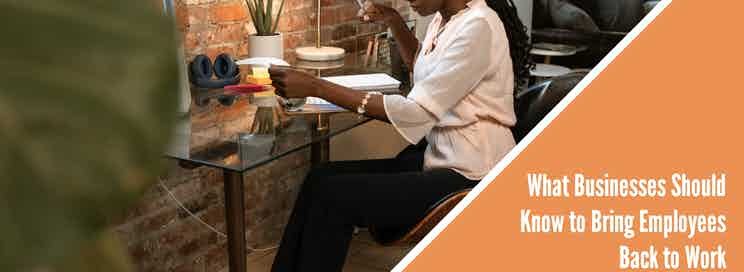Businesses wishing to entice workers from their current work-from-home status back to the office must establish a strong platform predicated on trust and demonstrate a clear and ongoing commitment to worker health and safety through facility hygiene and sanitation protocols.

Building a Bridge of Trust to Bring Workers Back to the Office
Widespread uncertainty due to the COVID-19 pandemic has dramatically altered the human experience--how we choose to interact with our built and natural environments, the standards we choose to hold societal leaders to, and the consequences we choose to impose on public institutions and organizations that violate our trust and compromise our safety.
Uncertainty combined with inconsistent action has resulted in an erosion of trust on the part of office workers, directed at their employers, resulting in a decline in workplace motivation, which is a strong indicator of workplace productivity.
According to a survey conducted by Deloitte Digital;
79% of employees who highly trust their employer feel motivated to work, [however];
[O]nly 29% of those who did not trust their employer are motivated to work.
Concerningly, of those who responded, only;
4% [...] trust businesses to define a safe path to normal during COVID.
A consequence of this erosion of trust is demonstrable in the hesitation of office workers to return to their conventional places of business after an extended work from home hiatus.
According to additional data collected by Deloitte Digital, of those responding to the survey:
- 81% of office workers with children wish to remain working from home.
- 74% of office workers without children wish to remain working from home.
- 77% of all respondents stated that, if provided with a choice, even if they knew their employer was taking precautions to protect their health, they would prefer to remain working from home.
The desire to work from home permanently is so strong, it extends to areas of the economy where doing so is not only impractical, it's likely impossible.
For example:
- 82% of hotel housekeeping and cleaning staff who responded to the survey stated they would prefer to work from home if given a choice, regardless of employer precautions.
The sentiment was echoed by:
- 90% of airline lounge representatives, and;
- 78% of servers, bartenders, and hosts.
To address the issue of worker uncertainty and encourage what appears to be a significant portion of the US workforce to return to the office, business owners and facility managers will need to provide:
- Safety Essentials - Hand sanitizer and routine surface cleaning and disinfection.
- Increased Controls - Employees want increased control of their safety, which includes the provision of disinfectant materials upon entering a facility to sanitize their workspace, and;
- Heightened Transparency - This includes both increased updates and direct lines of communication for top-level stakeholders to office workers and facility occupants regarding health and safety protocols and recommendations, status updates regarding occupant health, and visible cleaning efforts throughout the day.
Enhanced Cleaning and Disinfection as a Method to Increase Worker Trust
For businesses to restore worker trust and remove the uncertainty surrounding potential risks to personal health, the following actions should be taken:
- Keep restrooms and handwashing stations highly sanitized and ensure the facilities are fully stocked with soap and paper products.
- Provide occupants with free access to hand sanitizer at all entrances to your facility and restroom exits.
- Clean and disinfect fomite surfaces several times per day.
- Use day porter and daytime cleaning services to satisfy worker requirements for transparency into the cleaning and disinfection process.
- Deep clean and disinfect in the evenings.
- Provide office workers with disinfectant wipes and microfiber towels to clean their workstations.
- Send emails and use signage throughout the facility to communicate cleaning efforts, health and safety guidelines, and any occupant health issues to workers on a regular basis, ranging from daily to weekly, depending on their preference, and;
- Hire a professional cleaning service with the skills, tools, training, and personnel to address worker demand.
References & Resources
- Safety in times of uncertainty
- Open for business: What employers need to know and do to bring employees back to work
Takeaway
In times of increased uncertainty, organizations that invest in their worker's health--both mental and physical--and future will rise to the top.
For most businesses, addressing modern worker demands for office cleaning and hygiene is cost-prohibitive with an in-house team.
Outsourcing is a proven method for onboarding rising in-demand sustainable cleaning for health services, tools, and expertise for a fraction of the cost of maintaining a similar service with direct hires.
If you would like more information regarding the effectiveness of high-performance infection prevention and control measures, or if you would like to schedule a free, no-obligation onsite assessment of your facility's custodial needs, contact us today for a free quote!
In Bakersfield, CA, call (661) 437-3253
In Fresno, CA, call (559) 206-1059
In Valencia CA, or Santa Clarita CA, call (661) 437-3253
In Palmdale, CA or Lancaster, CA, call (661) 371-4756

